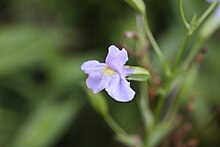| Mimulus ringens | |
|---|---|

| |
| Scientific classification | |
| Kingdom: | |
| Division: | |
| Class: | |
| Order: | |
| Family: | |
| Genus: | |
| Species: | M. ringens
|
| Binomial name | |
| Mimulus ringens L.
| |
Description edit
Mimulus ringens (Square-stemmed Monkeyflower) is a small Mimulus native to eastern North America. The monkeyflower (Mimulus genus) got its name from the flower petals which are fused together and resemble, at least to some people, a grinning face. Mimus in Latin means “little clown”.
Monkeyflowers are relatively common members of the snapdragon family (Scrophulariaceae) and are found all across the United States. They are showy plants with pink, violet, or yellow flowers, and several varieties have been popular as cultivated plants. Perhaps the best known species is Mimulus lewissi, a striking plant with shocking hot pink flowers which was named after Captain Meriwether Lewis of Lewis and Clark fame.
Range and dimensions edit
Our common native New Jersey monkeyflower has square stems and a pale pink or violet flower. White-flowered forms are sometimes found as well. The plant forms branched spikes 20’-30’ high which are covered with ¾” flowers in July and August. The plant is found from Canada west to Oklahoma, and south to Georgia and Louisana (1).
Monkeyflowers like neutral or slightly acid soil, and are easily grown and propagated. The very tiny seeds, which ripen in September and October, should be sprinkled on the surface of the soil and covered with evergreen boughs until germination begins the following spring. Some plants may flower the first year if conditions are just right. The plant is a long-lived hardy perennial, and a with a light mulch cover, numerous shoots will develop from the fiberous root stock year after year. Older plants can get quite bushy from underground stems which spring up from the main plant. Besides via seeds, propagation can be accomplished by dividing older clumps with a sharp knife in early spring, or by taking cuttings in early summer.
Uses and symbolism edit
Look for monkeyflowers along stream beds and in damp meadows, either in full sun or light shade. Although the plant normally grows with damp roots and thus is very useful in a rain garden, it will grow well in home gardens in ordinary soil as long as it is well watered during periods of drought. One way to insure extra moisture is to sink the plant bed 6” below the level of the surrounding soil. The lavender monkeyflower makes a nice companion plant to lilies, cardinal flower, gentian and white turtlehead. Our native hardy monkeyflower deserves to be more widely grown, as it will add color to your garden and perhaps a touch of humor.
References edit
- NJ Native Plant Soc. Newsletter, Vol IX No. 1, Winter 1991, pg1.
See also edit
<gallery> Image:Monkey flower brdgwtr 20080803 3288.JPG |General Habitat <gallery>